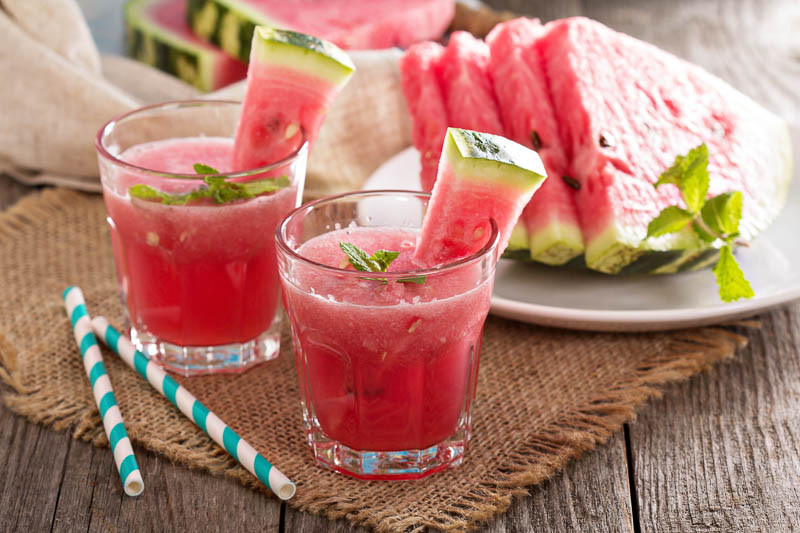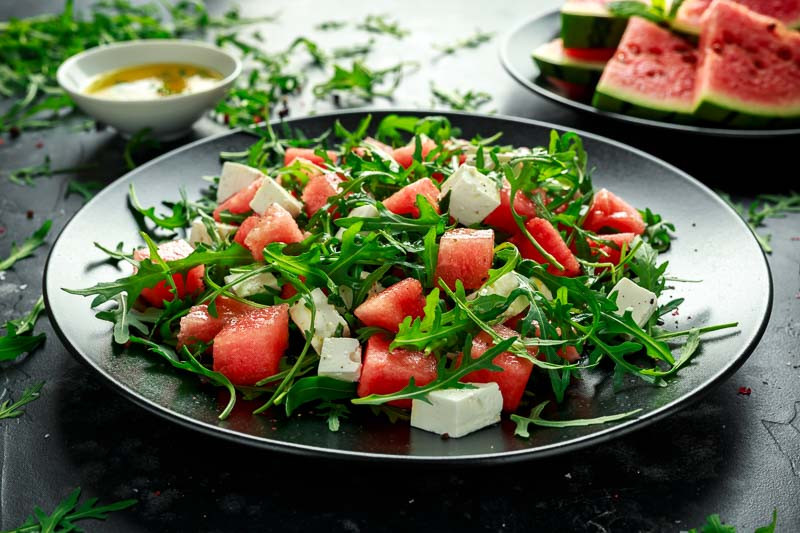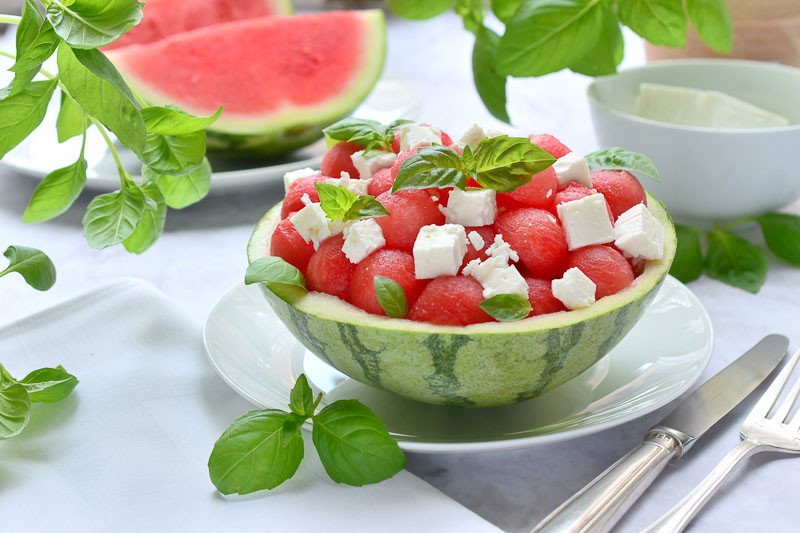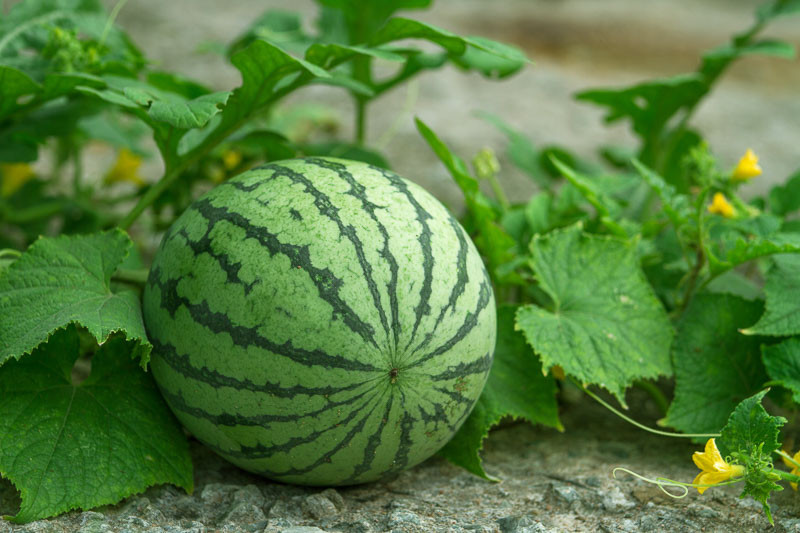Watermelon, Water Melon
A watermelon (Citrullus lanatus) is a large, sweet, and juicy fruit that belongs to the Cucurbitaceae family, which also includes other melons, cucumbers, and squashes. It is native to Africa and has been cultivated for thousands of years. The first recorded harvest occurred nearly 5,000 years ago in Egypt. There are more than 1,200 varieties grown in over 96 countries worldwide.
Description: Watermelons are large, usually oblong or round fruits with a thick, green, and sometimes striped rind. The flesh inside is typically red or pink, with many small black seeds, although seedless varieties also exist. Some less common varieties have yellow or orange flesh.
Growth habit: Watermelon plants are annual vines that grow along the ground and can spread 8-15 feet (2.4-4.5 meters) or more. They have large, lobed leaves and tendrils that help support the plant as it grows.
Size: Watermelons can vary greatly in size, from small personal-sized fruits weighing just a few pounds to massive fruits weighing over 100 pounds. Most commercial varieties range between 10 and 30 pounds.
Flowers: The flowers are yellow and approximately 1 inch (2.5 cm) in diameter. The plants are monoecious, meaning they produce separate male and female flowers on the same vine.
Blooming season: The plants typically bloom in late spring or early summer, depending on the local climate and the specific variety.
Hardiness: Watermelons are warm-season crops that require long, hot summers for optimal growth. They are sensitive to frost and cold temperatures, so they should be planted after the risk of frost has passed.
Uses: Watermelon is primarily consumed as a refreshing and hydrating fruit, either eaten fresh or used in various recipes such as salads, fruit salads, smoothies, and desserts. The rind can also be pickled, and the seeds can be roasted for consumption.
Pollinators: Watermelons require pollination by bees or other insects to set fruit. Honeybees are the most common pollinators, but other types of bees can also contribute to pollination.
Benefits: Watermelons are low in calories and rich in vitamins A and C, as well as antioxidants such as lycopene. They are also composed of about 92% water, making them a hydrating and refreshing fruit to consume during hot weather.

Watermelon is a popular fruit known for its refreshing taste and high water content. Here are the nutrition facts for a serving size of about 1 cup (154 grams) of diced watermelon:
Watermelon is also a good source of several essential vitamins and minerals:
In addition to these nutrients, they contain phytonutrients such as lycopene, a powerful antioxidant that has been linked to various health benefits, including reduced risk of heart disease and certain types of cancer. Lycopene content is 6,979 mcg per 100 grams, which is higher than in tomatoes.
Overall, watermelon is a low-calorie, hydrating fruit that provides essential nutrients and antioxidants, making it a healthy and refreshing choice.
Watermelon offers several health benefits due to its nutrient-rich profile and high water content. Some of these benefits include:
Hydration: Watermelon is composed of about 90% water, which can help you stay hydrated and maintain proper body functions.
Antioxidant properties: Watermelon is rich in antioxidants, particularly lycopene, which may help reduce oxidative stress and lower the risk of chronic diseases such as heart disease and certain types of cancer.
Heart health: Watermelon contains nutrients like potassium, magnesium, and lycopene, which are known to support heart health by regulating blood pressure, improving circulation, and reducing inflammation.
Anti-inflammatory effects: The presence of lycopene and vitamin C may have anti-inflammatory properties, which can help reduce inflammation and lower the risk of chronic diseases.
Aids digestion: Watermelon has a modest amount of dietary fiber, which can help promote healthy digestion and prevent constipation.
Supports skin and hair health: The vitamins A and C in watermelon contribute to healthy skin and hair. Vitamin A helps maintain healthy skin and mucous membranes, while vitamin C is essential for collagen production, which strengthens hair and supports skin elasticity.
Weight management: Watermelon is low in calories and high in water content, making it a filling, refreshing option for those looking to manage their weight.
Exercise performance and recovery: Watermelon contains an amino acid called citrulline, which may help improve blood flow and reduce muscle soreness after exercise.
Immune system support: The vitamin C content in watermelon helps support a healthy immune system by contributing to the production of white blood cells and acting as an antioxidant.
While watermelon offers various health benefits, it is essential to consume it as part of a balanced diet and maintain an overall healthy lifestyle.

Check the color: Look for a uniform, matte green color on the watermelon’s surface. A shiny surface can indicate that the fruit is underripe.
Inspect the spot: Watermelons develop a ground spot where they rest on the ground. A ripe fruit will have a creamy yellow or light brown spot, while an underripe one will have a white or pale green spot.
Examine the shape: A ripe watermelon should be uniform in shape, without any flat sides, bumps, or irregularities. Irregularities can indicate uneven growth or incomplete ripening.
Test the weight: A ripe watermelon should feel heavy for its size. This is because water content increases as the fruit ripens, making it heavier.
Knock on it: Gently tap or knock on the watermelon with your knuckles. A ripe watermelon will produce a deep, hollow sound, while an underripe one will have a higher-pitched or dull sound.
Wash and sanitize: Rinse the watermelon under running water and pat dry. This will help remove any dirt, bacteria, or pesticide residue.
Cut off the ends: Using a large, sharp knife, slice off both ends of the watermelon to create a stable, flat surface for cutting.
Halve the watermelon: Stand the watermelon on one of the flat ends and carefully slice down through the center to create two equal halves.
Quarter the watermelon: Place each half cut-side down and slice through the center again, creating four equal quarters.
Remove the rind: Hold one of the watermelon quarters with the rind facing away from you. Starting at the top, carefully slice off the rind, following the curve of the fruit. Repeat with the remaining quarters.
Cut the flesh: Lay each rind-free quarter on its side and slice it into 1-2 inch (2-5 cm) thick pieces, creating triangular wedges.
Serve or store: Arrange the watermelon wedges on a platter or store them in an airtight container in the refrigerator for up to 3-4 days.
Remember to always use caution when cutting any fruit, especially with a sharp knife. Enjoy your freshly cut watermelon!

There are various ways to enjoy watermelon, from simple to creative. Here are some ideas for eating watermelon:
Slice and eat: The most traditional way to eat watermelon is to simply slice it into wedges or cut it into cubes and enjoy it fresh. Make sure to refrigerate the watermelon before cutting it for a more refreshing taste.
Fruit salad: Cube or scoop out watermelon balls and mix them with other fruits like pineapple, grapes, berries, and kiwi to create a colorful and delicious fruit salad.
Watermelon smoothie: Blend watermelon chunks with ice, yogurt, or milk and other fruits like strawberries or bananas for a refreshing smoothie. You can also add mint leaves or a splash of lime juice for added flavor.
Watermelon juice: Puree watermelon chunks in a blender or juicer, then strain the mixture through a fine-mesh sieve to remove any seeds or pulp. Enjoy the juice on its own, or mix it with other fruit juices, lemonade, or sparkling water.
Grilled watermelon: Cut watermelon into thick slices or large cubes, brush with a small amount of olive oil, and grill for a few minutes on each side until lightly charred. Grilled watermelon pairs well with feta cheese and fresh mint or basil.
Watermelon salsa: Dice watermelon and mix it with diced cucumber, jalapeno, red onion, chopped cilantro, lime juice, and salt for a unique and refreshing salsa. Serve with tortilla chips or as a topping for grilled fish or chicken.
Watermelon salad: Cube watermelon and combine with crumbled feta cheese, chopped mint leaves, and a light dressing of olive oil, lime juice, salt, and pepper for a sweet and savory salad.
Watermelon popsicles: Puree watermelon and pour the mixture into popsicle molds, then freeze until solid. For added flavor, mix in other fruit purees, fruit pieces, or a splash of lime juice.
Watermelon gazpacho: Blend watermelon with cucumber, bell pepper, onion, garlic, jalapeno, and tomato, along with some vinegar, olive oil, salt, and pepper for a cold, refreshing summer soup.
Watermelon pizza: Slice watermelon into large rounds, then top with your favorite fruits, yogurt, honey, nuts, or granola for a fun and healthy “pizza” snack.
These are just a few of the many ways you can enjoy watermelon. Don’t be afraid to get creative and experiment with different flavors and combinations to find your favorite way to eat this delicious and versatile fruit.
Growing a watermelon plant can be a rewarding and enjoyable experience for several reasons. Here are some reasons you might consider growing a watermelon plant:
Homegrown taste: Homegrown watermelons often taste better than store-bought ones because they can be harvested at their peak ripeness, ensuring maximum flavor and sweetness.
Health benefits: Watermelons are rich in vitamins, minerals, and antioxidants, making them a healthy addition to your diet. By growing your own, you can ensure that they are grown organically and free from harmful pesticides.
Gardening therapy: Gardening is a therapeutic and relaxing activity that has been shown to reduce stress and improve mental well-being. Growing watermelon plants can be a gratifying way to connect with nature and enjoy the outdoors.
Educational opportunity: Growing a watermelon plant can be an excellent educational opportunity, especially for children. It teaches patience, responsibility, and the importance of nurturing living organisms. Plus, kids are more likely to eat fruits and vegetables they helped grow.
Environmental benefits: Growing your own fruits and vegetables helps reduce the carbon footprint associated with transporting produce from distant locations. Plus, you can use environmentally friendly practices like composting and rainwater harvesting to further minimize your environmental impact.
Save money: Growing your own watermelon can save you money, as store-bought watermelons can be relatively expensive, especially during the off-season.
Unique varieties: There are many different varieties of watermelon, some of which may not be available at your local grocery store. By growing your own, you can choose from a wide array of types, sizes, and flavors to suit your personal preferences.
Social connections: Sharing your homegrown watermelons with friends, family, and neighbors can foster a sense of community and encourage others to start their own gardens.
Overall, growing a watermelon plant can be a fun and rewarding endeavor with numerous benefits for your health, well-being, and the environment.

Growing and caring for a watermelon plant is a relatively straightforward process, but it does require some attention to detail. Here’s a step-by-step guide to help you grow a healthy and productive watermelon plant:
Choose the right variety: Select a watermelon variety that is suitable for your climate and growing conditions. There are many varieties available, each with its own unique characteristics, such as size, flavor, and growth habits. Some popular varieties include Sugar Baby, Crimson Sweet, and Black Diamond.
Prepare the soil: Watermelon plants thrive in well-draining, loamy soil with a pH between 6.0 and 7.5. Amend your soil with organic matter, such as compost or well-rotted manure, to improve drainage and fertility. If your soil is too acidic or alkaline, adjust the pH using lime or sulfur, respectively.
Choose the right location: Watermelon plants require full sun, so select a location that receives at least 6-8 hours of direct sunlight per day. Make sure the area has good air circulation to help prevent fungal diseases. Watermelon needs a lot of space to grow – make sure your plant will have enough room to grow without crowding out other crops.
Planting: Watermelons are sensitive to cold temperatures, so wait until the soil has warmed to at least 65°F (18°C) before planting. You can start seeds indoors 2-3 weeks before the last frost date or sow seeds directly in the ground. Plant seeds 1 inch deep (2.5 cm) and about 3 feet (90 cm) apart in rows that are 6-8 feet (1.8-2.4 meters) apart. If you’re using seedlings, transplant them carefully to avoid disturbing the roots.
Watering: Watermelons have deep root systems, which means they require consistent, deep watering. Provide 1-2 inches (2-5 cm) of water per week, preferably through drip irrigation or a soaker hose, to keep the foliage dry and reduce the risk of disease. Water the plants early in the day to allow the foliage to dry before nightfall.
Fertilizing: Apply a balanced fertilizer (such as 10-10-10) when planting and again when the plants begin to vine. You can also use compost or well-rotted manure as a side dressing. Avoid excessive nitrogen, as it can promote excessive foliage growth at the expense of fruit development.
Pollination: Watermelons are pollinated by bees, so make sure there are plenty of flowers in your garden to attract these essential pollinators. You can also hand-pollinate by transferring pollen from male flowers to female flowers using a small brush or cotton swab.
Harvesting: Watermelons typically take 70-90 days from planting to reach maturity, depending on the variety. Look for signs of ripeness, such as a dull thumping sound when tapped, a creamy-yellow spot on the underside where the fruit was resting on the ground, and the tendril nearest to the fruit turning brown and drying out.
By following these steps, you can successfully grow and care for a watermelon plant, enjoying the delicious and refreshing fruits of your labor.
Watermelon is typically propagated by seeds, as this is the most common and straightforward method. Here’s a step-by-step guide on how to propagate watermelon from seeds:
Select seeds: Choose seeds from a reliable source or save seeds from a ripe, healthy watermelon. Keep in mind that hybrid varieties may not produce fruits true to the parent plant, so it’s best to use seeds from open-pollinated or heirloom varieties for consistent results.
Seed preparation: If you have saved seeds from watermelon, rinse them thoroughly to remove any residue and let them air-dry completely. Store the dry seeds in a cool, dark, and dry place until you’re ready to plant.
Seed germination: Watermelon seeds germinate best at temperatures between 70°F and 95°F (21°C and 35°C). You can start seeds indoors 2-3 weeks before your last frost date or sow them directly in the ground once the soil temperature has reached at least 65°F (18°C).
Indoor sowing: If starting seeds indoors, fill seedling trays or small pots with a sterile seed-starting mix. Plant the seeds about 1 inch (2.5 cm) deep, and water them gently to moisten the soil. Place the containers in a warm location or use a seedling heat mat to maintain the ideal germination temperature. Seeds should germinate within 5-10 days.
Transplanting: Once the seedlings have developed two true leaves and the danger of frost has passed, you can transplant them to your garden. Harden off the seedlings by gradually exposing them to outdoor conditions over a period of 7-10 days. Plant the seedlings 3 feet (90 cm) apart in rows that are 6-8 feet (1.8-2.4 meters) apart.
Direct sowing: If sowing seeds directly in the ground, wait until the soil temperature has warmed to at least 65°F (18°C). Plant the seeds about 1 inch (2.5 cm) deep and 3 feet (90 cm) apart in rows that are 6-8 feet (1.8-2.4 meters) apart. Thin the seedlings once they have developed their first true leaves, leaving the strongest plant at each location.
By following these steps, you can successfully propagate watermelon plants from seeds. Although watermelon can be propagated by cutting or grafting, these methods are less common and typically used for research or commercial production purposes.
Watermelons can be affected by various pests and diseases. Here is a list of some common ones and how to manage them:
Aphids: These tiny, sap-sucking insects can cause stunted growth, yellowing leaves, and transmit viral diseases. To control aphids, release beneficial insects like ladybugs and lacewings, use insecticidal soap, or apply neem oil to the affected plants.
Cucumber beetles: These beetles can cause severe damage by feeding on leaves, flowers, and fruits. They can also transmit bacterial wilt. To manage cucumber beetles, use floating row covers to protect young plants, set up yellow sticky traps, and apply botanical insecticides like pyrethrum or neem oil.
Spider mites: These tiny pests can cause stippling and yellowing of leaves, leading to defoliation and reduced plant vigor. To control spider mites, maintain proper watering to reduce plant stress, release predatory mites, or use miticides like horticultural oil or insecticidal soap.
Squash bugs: These insects feed on leaves, causing wilting and yellowing. Handpick and destroy squash bugs and their eggs, use floating row covers or apply insecticides like neem oil or pyrethrum.
Powdery mildew: This fungal disease appears as a white, powdery substance on leaves, which can lead to reduced photosynthesis and plant vigor. To prevent and control powdery mildew, ensure good air circulation around the plants, apply fungicides like sulfur or potassium bicarbonate, and remove affected leaves.
Anthracnose: This fungal disease causes dark, sunken lesions on leaves, stems, and fruits. To manage anthracnose, practice crop rotation, avoid overhead watering, and apply a fungicide like copper or chlorothalonil.
Fusarium wilt: This soil-borne fungal disease causes yellowing and wilting of leaves, leading to plant death. To prevent fusarium wilt, choose resistant varieties, practice crop rotation, and maintain proper soil fertility and pH.
Gummy stem blight: This fungal disease causes lesions on stems, leaves, and fruits, leading to plant collapse. To control gummy stem blight, practice crop rotation, remove infected plant debris, and apply fungicides like copper or mancozeb.
Root-knot nematodes: These microscopic worms can cause stunted growth, yellowing leaves, and galls on roots. To manage root-knot nematodes, practice crop rotation, solarize the soil, and use organic soil amendments like compost and aged manure to promote healthy soil.
To reduce the likelihood of pests and diseases in your watermelon plants, practice good garden hygiene, maintain proper plant spacing, and use crop rotation. Regularly inspect your plants for signs of problems and take prompt action when necessary.
Can dogs eat watermelon?
Yes, dogs can eat watermelon in moderation, as long as you remove the seeds and rind, as these can cause gastrointestinal blockages. Watermelon is a hydrating, low-calorie treat that is high in vitamins and minerals, making it a healthy snack for dogs.
Is watermelon good for you?
Yes, watermelon is an excellent source of vitamins A and C, potassium, and antioxidants like lycopene. It is low in calories and high in water content, making it a refreshing and hydrating snack that can aid in weight management and overall health.
Can cats eat watermelon?
Cats can eat small amounts of watermelon, but it is not a necessary part of their diet. Ensure that you remove the seeds and rind before offering watermelon to your cat to avoid potential choking hazards or gastrointestinal issues.
How many calories are in watermelon?
Watermelon is low in calories, with approximately 46 calories per one cup (154g) of diced watermelon.
Is watermelon healthy?
Yes, watermelon is a healthy fruit option due to its high water content, low calorie count, and rich nutrient profile, which includes vitamins, minerals, and antioxidants.
How many carbs are in watermelon?
Watermelon contains approximately 11.5 grams of carbohydrates per one cup (154g) of diced watermelon. Most of these carbohydrates come from natural sugars, with a small amount from dietary fiber.
Can you freeze watermelon?
Yes, you can freeze watermelon, although the texture may change once it is thawed. To freeze watermelon, remove the rind and cut the fruit into small pieces or cubes. Place the pieces on a baking sheet lined with parchment paper, making sure they are not touching, and freeze until solid. Once frozen, transfer the watermelon pieces to an airtight container or freezer bag for storage. Frozen watermelon can be enjoyed as a cold snack or added to smoothies and other recipes.
| Hardiness |
2 - 11 |
|---|---|
| Climate Zones | 1, 1A, 1B, 2, 2A, 2B, 3, 3A, 3B, 4, 5, 6, 7, 8, 9, 10, 11, 12, 13, 14, 15, 16, 17, 18, 19, 20, 21, 22, 23, 24, H1, H2 |
| Plant Type | Annuals, Climbers, Fruits |
| Plant Family | Cucurbitaceae |
| Exposure | Full Sun |
| Season of Interest |
Summer (Mid, Late) |
| Height |
10" - 2' (25cm - 60cm) |
| Spread |
8' - 15' (240cm - 4.6m) |
| Maintenance | Average |
| Water Needs | Average |
| Soil Type | Loam |
| Soil pH | Acid, Alkaline, Neutral |
| Soil Drainage | Moist but Well-Drained |
| Characteristics | Showy |
| Attracts | Bees |
| Garden Uses | Beds And Borders |
| Garden Styles | Informal and Cottage |
Africa Studio, Elena Veselova, Decha Sukprasert, Nodar Chernishev, Shutterstock
| Hardiness |
2 - 11 |
|---|---|
| Climate Zones | 1, 1A, 1B, 2, 2A, 2B, 3, 3A, 3B, 4, 5, 6, 7, 8, 9, 10, 11, 12, 13, 14, 15, 16, 17, 18, 19, 20, 21, 22, 23, 24, H1, H2 |
| Plant Type | Annuals, Climbers, Fruits |
| Plant Family | Cucurbitaceae |
| Exposure | Full Sun |
| Season of Interest |
Summer (Mid, Late) |
| Height |
10" - 2' (25cm - 60cm) |
| Spread |
8' - 15' (240cm - 4.6m) |
| Maintenance | Average |
| Water Needs | Average |
| Soil Type | Loam |
| Soil pH | Acid, Alkaline, Neutral |
| Soil Drainage | Moist but Well-Drained |
| Characteristics | Showy |
| Attracts | Bees |
| Garden Uses | Beds And Borders |
| Garden Styles | Informal and Cottage |
How many Citrullus lanatus (Watermelon) do I need for my garden?
| Plant | Quantity | |
|---|---|---|
| Citrullus lanatus (Watermelon) | N/A | Buy Plants |
Create a membership account to save your garden designs and to view them on any device.
Becoming a contributing member of Gardenia is easy and can be done in just a few minutes. If you provide us with your name, email address and the payment of a modest $25 annual membership fee, you will become a full member, enabling you to design and save up to 25 of your garden design ideas.
Join now and start creating your dream garden!
Create a membership account to save your garden designs and to view them on any device.
Becoming a contributing member of Gardenia is easy and can be done in just a few minutes. If you provide us with your name, email address and the payment of a modest $25 annual membership fee, you will become a full member, enabling you to design and save up to 25 of your garden design ideas.
Join now and start creating your dream garden!